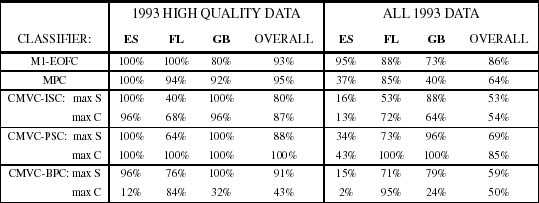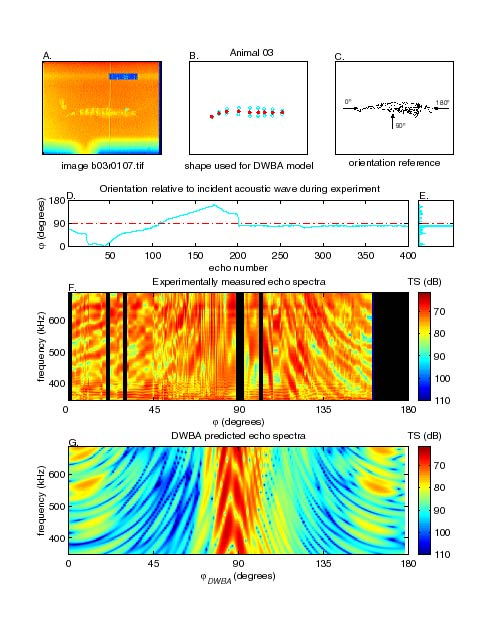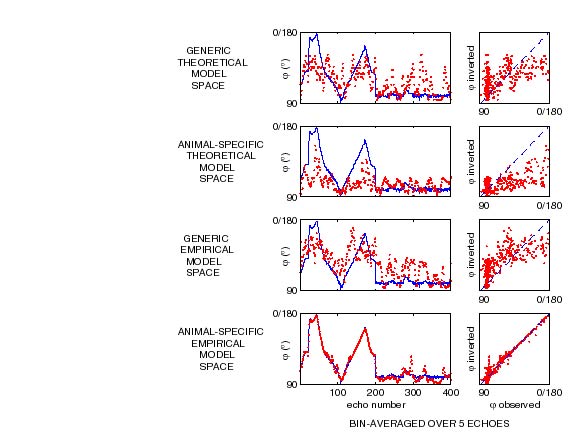Acoustic Classification of Zooplankton
Linda V. Martin Traykovski
For my thesis work, I studied the inverse problem in zooplankton
bioacoustics: the classification of individual zooplankton based on spectral
characteristics of their broadband acoustic echoes. Members of this lab
(Tim Stanton, Dezhang Chu) and others have done extensive work on the forward
problem (described elsewhere on the Stanton Scattering Lab web pages).
One result of this work has been the identification of three categories
of zooplankton acoustic scatterers: elastic-shelled (e.g. pteropods), fluid-like
(e.g. euphausiids), and gas-bearing (e.g. siphonophores). This work also
showed that the relationship between backscattered acoustic energy and
animal biomass can vary by a factor of ~19,000 across these categories!
This means that different types of zooplankton do not contribute equally
to the backscattered signal measured in acoustic surveys of the ocean.
In regions with mixed-species assemblages of zooplankton such as Georges
Bank and the Gulf of Maine, biomass estimates based on acoustic surveys
will be highly inaccurate if all zooplanton are assumed to scatter the
same amount of acoustic energy per unit biomass. Fortunately, by insonifying
individual zooplankton from each of the three acoustic categories, we discovered
characteristics of their broadband echoes that would allow discrimination
between members of different groups. Representative zooplankton from the
three scattering classes are shown below, along with echoes (points) collected
from broadband insonifications of animals in each class, and theoretical
models (solid lines) that describe the acoustic scattering from these classes
(see Stanton et al. 1998 for details of the models):


In the course of my thesis work, I developed both feature based and
model based classification techniques to invert broadband acoustic echoes
from individual zooplankton for scatterer type, as well as for particular
parameters such as animal orientation. The feature based Empirical Orthogonal
Function Classifier (EOFC) discriminates scatterer types by identifying
characteristic modes of variability in the echo spectra, exploiting only
the inherent characteristic structure of the acoustic signatures (Martin
et al. 1996). The model based Model Parameterisation Classifier
(MPC) classifies based on correlation of observed echo spectra with simplified
parameterisations of theoretical scattering models for the three classes
(Martin et al. 1996). The Covariance Mean Variance Classifiers (CMVC)
are a set of advanced model based techniques which exploit the full complexity
of the theoretical models by searching the entire physical model parameter
space without employing simplifying parameterisations (Martin Traykovski
et al. 1998a). Three different CMVC algorithms were developed: the
Integrated Score Classifier (ISC), the Pairwise Score Classifier (PSC)
and the Bayesian Probability Classifier (BPC); these classifiers assign
observations to a class based on similarities in covariance, mean, and
variance, while accounting for model ambiguity and validity. These feature
based and model based inversion techniques were successfully applied to
several thousand echoes acquired from broadband (~350 kHz - 750 kHz) insonifications
of live zooplankton collected on Georges Bank and the Gulf of Maine to
determine scatterer class. The table below summarises the performance (%
correctly classified) of the different classification algorithms:

Another aspect of this classification work involved characterising
the effect of zooplankton orientation on the return echoes. We discovered
that the acoustic returns of the animals in a given scattering class varied
depending on their angle of orientation to the incident acoustic wave.
To investigate this, a high-magnification underwater video camera was used
to film each animal during insonification (Martin Traykovski et
al. 1998b). The audio channel of the video tape was marked each time
the animal was pinged, so that a one-to-one correspondence between each
echo and the animal's orientation at the time of insonification could be
made. The figure below shows A. a video image of an Antarctic krill (Euphausia
superba), D. a time series of angle of orientation (j)
for this animal during insonification, F. experimentaly measured echo spectra
(y-axis, target strength (TS) in colour) plotted vs. orientation (x-axis),
and G. theoretical model predictions based on a distorted-wave Born approximation
(DWBA) model using the digitised animal shape in B:
 Although the echo spectra vary widely depending on the orientation of the
animal, the pattern of changes with angle is well-predicted by the DWBA
model. The CMVC techniques were then applied to echoes from these fluid-like
zooplankton to invert for angle of orientation using both generic and animal-specific
theoretical and empirical models (Martin Traykovski et al.
1998b). Results of the inversions using these different model spaces is
shown below for Animal 03 (observed angle of orientation j
(solid blue line) is shown together with inversion results (red points);
dashed blue lines in scatter plots at right indicate perfect correspondence
between inversion results and observations):
Although the echo spectra vary widely depending on the orientation of the
animal, the pattern of changes with angle is well-predicted by the DWBA
model. The CMVC techniques were then applied to echoes from these fluid-like
zooplankton to invert for angle of orientation using both generic and animal-specific
theoretical and empirical models (Martin Traykovski et al.
1998b). Results of the inversions using these different model spaces is
shown below for Animal 03 (observed angle of orientation j
(solid blue line) is shown together with inversion results (red points);
dashed blue lines in scatter plots at right indicate perfect correspondence
between inversion results and observations):

In summary, the classification techniques developed as part of my thesis
can be used to invert broadband acoustic echoes from individual zooplankton
for scatterer type as well as scatterer angle of orientation. Once the
technology is sufficiently developed to make high SNR broadband insonifications
of individuals in situ, the application of these inversion techniques
in the field will allow correct apportionment of backscattered energy to
animal biomass. The in situ use of these acoustic classification
algorithms has the potential to significantly improve estimates of zooplankton
biomass based on acoustic surveys.
I am currently expanding these inversion approaches in my post-doctoral
work. I am interested in applying similar ideas to classify optical water
types in large ocean regions (e.g. the Northwest Atlantic including Georges
Bank and the Gulf of Maine) based on spectral information obtained remotely
from satellite ocean colour sensors such as SeaWiFS (Sea-viewing Wide Field
of View Sensor) aboard the SeaStar satellite, which was launched in July
1997. A summary of some preliminary results of this new work (Martin Traykovski
and Sosik 1998) can be found by following this link: Optical
Classification of Water Types based on Remotely-Sensed Ocean Colour.
REFERENCES:
Martin Traykovski, Linda V. 1998. Acoustic Classification of
Zooplankton. Ph.D. Thesis, 185 pp., Massachusetts Institute
of Technology / Woods Hole Oceanographic
Institution Joint Program, MIT/WHOI, 98-04.
Martin, L.V., T.K. Stanton, P.H. Wiebe, and J.F. Lynch. 1996.
Acoustic classification of zooplankton.
ICES Journal of Marine Science, 53:
217-224.
Martin Traykovski, L.V., T.K. Stanton, P.H. Wiebe, and J.F. Lynch.
1998a. Model based Covariance
Mean Variance Classification (CMVC)
techniques: Algorithm development and application to the acoustic
classification of zooplankton. IEEE
Journal of Oceanic Engineering, 23(4): 344-364.
Martin Traykovski, L.V., R.L. O’Driscoll, D.E. McGehee. 1998b.
Effect of orientation on the broadband
acoustic scattering of Antarctic Krill
(Euphausia superba): Implications for inverting zooplankton spectral acoustic
signatures for angle of orientation.
Journal of the Acoustical Society of America, 104(4): 2121-2135.
Martin Traykovski, L.V. and H.M. Sosik. 1998. Optical classification
of water types based on remotely-sensed
ocean colour. Contributed Papers, Ocean
Optics XIV, Kailua-Kona, HI, 10-13 November 1998.
This page created and maintained by Linda
Martin Traykovski (click here to visit my home page)





